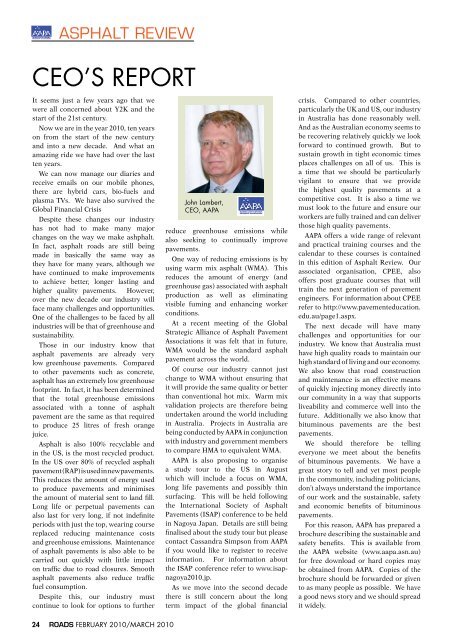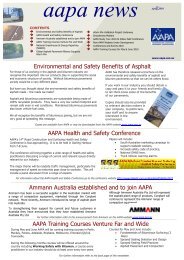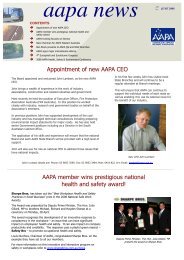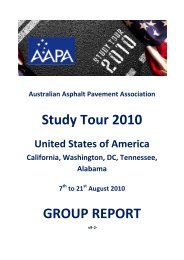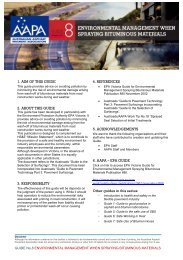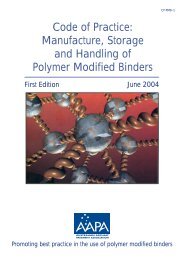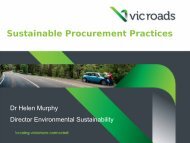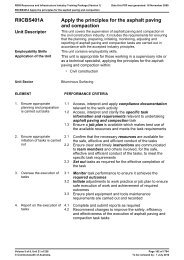Asphalt Review - Volume 29 Number 1 (February / March 2010)
Asphalt Review - Volume 29 Number 1 (February / March 2010)
Asphalt Review - Volume 29 Number 1 (February / March 2010)
- No tags were found...
You also want an ePaper? Increase the reach of your titles
YUMPU automatically turns print PDFs into web optimized ePapers that Google loves.
ASPHALT REVIEWCEO’s reportIt seems just a few years ago that wewere all concerned about Y2K and thestart of the 21st century.Now we are in the year <strong>2010</strong>, ten yearson from the start of the new centuryand into a new decade. And what anamazing ride we have had over the lastten years.We can now manage our diaries andreceive emails on our mobile phones,there are hybrid cars, bio-fuels andplasma TVs. We have also survived theGlobal Financial CrisisDespite these changes our industryhas not had to make many majorchanges on the way we make ashphalt.In fact, asphalt roads are still beingmade in basically the same way asthey have for many years, although wehave continued to make improvementsto achieve better, longer lasting andhigher quality pavements. However,over the new decade our industry willface many challenges and opportunities.One of the challenges to be faced by allindustries will be that of greenhouse andsustainability.Those in our industry know thatasphalt pavements are already verylow greenhouse pavements. Comparedto other pavements such as concrete,asphalt has an extremely low greenhousefootprint. In fact, it has been determinedthat the total greenhouse emissionsassociated with a tonne of asphaltpavement are the same as that requiredto produce 25 litres of fresh orangejuice.<strong>Asphalt</strong> is also 100% recyclable andin the US, is the most recycled product.In the US over 80% of recycled asphaltpavement (RAP) is used in new pavements.This reduces the amount of energy usedto produce pavements and minimisesthe amount of material sent to land fill.Long life or perpetual pavements canalso last for very long, if not indefiniteperiods with just the top, wearing coursereplaced reducing maintenance costsand greenhouse emissions. Maintenanceof asphalt pavements is also able to becarried out quickly with little impacton traffic due to road closures. Smoothasphalt pavements also reduce trafficfuel consumption.Despite this, our industry mustcontinue to look for options to furtherJohn Lambert,CEO, AAPAreduce greenhouse emissions whilealso seeking to continually improvepavements.One way of reducing emissions is byusing warm mix asphalt (WMA). Thisreduces the amount of energy (andgreenhouse gas) associated with asphaltproduction as well as eliminatingvisible fuming and enhancing workerconditions.At a recent meeting of the GlobalStrategic Alliance of <strong>Asphalt</strong> PavementAssociations it was felt that in future,WMA would be the standard asphaltpavement across the world.Of course our industry cannot justchange to WMA without ensuring thatit will provide the same quality or betterthan conventional hot mix. Warm mixvalidation projects are therefore beingundertaken around the world includingin Australia. Projects in Australia arebeing conducted by AAPA in conjunctionwith industry and government membersto compare HMA to equivalent WMA.AAPA is also proposing to organisea study tour to the US in Augustwhich will include a focus on WMA,long life pavements and possibly thinsurfacing. This will be held followingthe International Society of <strong>Asphalt</strong>Pavements (ISAP) conference to be heldin Nagoya Japan. Details are still beingfinalised about the study tour but pleasecontact Cassandra Simpson from AAPAif you would like to register to receiveinformation. For information aboutthe ISAP conference refer to www.isapnagoya<strong>2010</strong>.jp.As we move into the second decadethere is still concern about the longterm impact of the global financialcrisis. Compared to other countries,particularly the UK and US, our industryin Australia has done reasonably well.And as the Australian economy seems tobe recovering relatively quickly we lookforward to continued growth. But tosustain growth in tight economic timesplaces challenges on all of us. This isa time that we should be particularlyvigilant to ensure that we providethe highest quality pavements at acompetitive cost. It is also a time wemust look to the future and ensure ourworkers are fully trained and can deliverthose high quality pavements.AAPA offers a wide range of relevantand practical training courses and thecalendar to these courses is containedin this edition of <strong>Asphalt</strong> <strong>Review</strong>. Ourassociated organisation, CPEE, alsooffers post graduate courses that willtrain the next generation of pavementengineers. For information about CPEErefer to http://www.pavementeducation.edu.au/page1.aspx.The next decade will have manychallenges and opportunities for ourindustry. We know that Australia musthave high quality roads to maintain ourhigh standard of living and our economy.We also know that road constructionand maintenance is an effective meansof quickly injecting money directly intoour community in a way that supportsliveability and commerce well into thefuture. Additionally we also know thatbituminous pavements are the bestpavements.We should therefore be tellingeveryone we meet about the benefitsof bituminous pavements. We have agreat story to tell and yet most peoplein the community, including politicians,don’t always understand the importanceof our work and the sustainable, safetyand economic benefits of bituminouspavements.For this reason, AAPA has prepared abrochure describing the sustainable andsafety benefits. This is available fromthe AAPA website (www.aapa.asn.au)for free download or hard copies maybe obtained from AAPA. Copies of thebrochure should be forwarded or givento as many people as possible. We havea good news story and we should spreadit widely.24 ROADS FEBRUARY <strong>2010</strong>/MARCH <strong>2010</strong>


